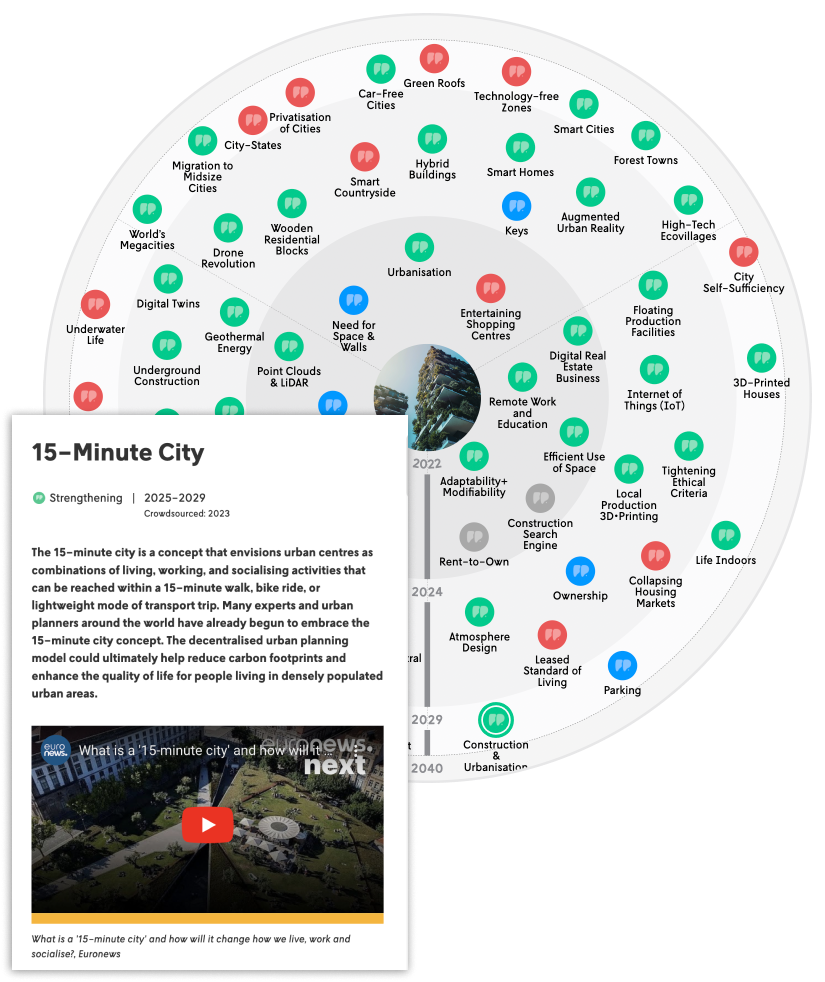
FUTURES OF URBAN PLANNING AND CONSTRUCTION
Discover what’s next for cities and assess the long-term global implications of the changing urban ecosystem with Futures Platform's futurist-curated trend database






Future of Urban Planning and Construction: Overview

ACCESS IN-DEPTH TREND ANALYSES ON URBAN PLANNING
Futures Platform’s foresight database hosts more than 1000 in-depth analyses of future trends, innovations and disruptions across all sectors globally, created by a team of world’s leading futurists. Dozens of new trend cards are added each month, and existing ones updated regularly.
On top of this, our experts have put together an in-depth foresight study on what the urban planning and construction sector may look like by 2040, covering the entire city ecosystem.
Our rich selection of trends and change signals provides a comprehensive look into the sector’s future, with insights on urban planning, construction, transportation and infrastructure, new technologies, regulations as well as changing lifestyles and larger societal shifts.
Here’s a sneak peek into some of the urban planning and construction trends available on Futures Platform:
15-Minute City
Affordable Housing
Buildings as Material Banks
Community Gardens
Removal of Urban Highways
Rural-Urban Hybrid Life
Self-Maintaining Buildings
Smart & Connected Countryside
Smart Traffic Lights
Tactical Urbanism
Learn more about what a Futures Platform trend card typically contains and see an example card in our blog.
VISUALISE THE FUTURE OF CITIES WITH INTERACTIVE FORESIGHT RADARS
Explore interconnections between trends, visualise alternative futures and collaborate with your team using Futures Platform’s interactive foresight radars. With the radars, you can:
Access ready-made, futurist-created radar templates on the Urbanisation & Construction sectors and 40+ more radars on adjacent industries such as Public Transportation, Services, Energy, and Politics & Policies
Modify the ready-made radars to fit your needs or create your own radar views from scratch
Use the built-in voting, rating and commenting tools to collect insights from your team and prioritise the most relevant trends for your organisation’s future

LATEST INSIGHTS ON THE FUTURE OF CITIES AND URBAN PLANNING
By 2100, all of the world's 20 largest megacities will be located in the developing world, with the majority in Africa. What implications will this shift have for the future of the global economy, climate, and the welfare of these urban populations?
New players in the housing industry are stepping up with all-inclusive packaged housing in holiday destinations ranging from old-world glamour to modern metropolis and ocean cruises – not of a lifetime, but rather, for a lifetime.
Europe spent years negotiating, innovating and planning to solve its net-zero energy policy puzzle by 2050. Will Russia’s war on Ukraine reshape the future of energy in the continent?
As the cost of traditional building materials rise, the construction industry may learn that going green is shifting from being too expensive to do, to too expensive not to do.
Often referred to as the ‘solo economy’ or ‘singles economy’, the growing prevalence of this household unit will have many implications for consumer brands who’ve long assumed that the default household consists of multiple people.
A new wave of sustainable urbanism focuses on bringing nature into the heart of the cities.
With over one million people moving to cities every week globally, the world is currently undergoing the biggest wave of urbanisation in human history . As urban populations increase, future cities will also face an array of new challenges.
Despite the pandemic, the larger trends in the transportation industry are not going away. The need for more environmentally friendly, resilient and comfortable ways to move around will persist and reassert itself after the lockdowns have ended.
Vanlife has been a growing trend among bohemian digital nomads for the past decade, but in the future when people start travel again, the romantic hippie vehicle might be increasingly replaced by ultramodern portable homes with more convenient facilities. And where the world once was an oyster for travellers, it is possible they will now be happy only with a slice of that: their local hoods and woods.
Nowadays, we have Singapore, Monaco, and the Vatican as the modern independent city-states; whereas cities such as Hong Kong, Macau, and Dubai are autonomous cities - independently functioning with their own governments but are still part of larger nations.
Last-mile delivery usually refers to the transportation of goods from a transportation hub (such as a warehouse) to the final destination (consumer's homes). It might not sound like an area that particularly favors a lot of innovation – but it does. In this article, we explore why it matters.
About 90% of the world's commodities are carried by the international shipping industry, annually. Liner shipping also transports around USD 4 trillion of goods yearly. There are more than 8,000 thousand of ports in over 200 countries worldwide. Here are their current challenges and future trends.
China has had a bad reputation with regard to the environment for many years. But understanding that looking out for the environment has benefits both internationally and domestically; the country has been changing. In fact, some may even argue that China is, at the moment, leading the cleantech revolution - ahead of the United States and other Western countries.
The modular home isn't a new concept. Look at any long-term construction site, military complex, or industrial space, and you are likely to find a few. Could they also serve as the future homes for a rapidly growing human population?
You take off from home, get in your car, arrive at the company office, take the elevator, and sit at your desk. For most white-collar workers, that used to be a typical routine. You get your work done at your desk in the company's offices. But in the past couple of years there has been a growing trend toward co-shared office spaces. In this article, have a look at this trend.
It's estimated that by 2050, global food demand will increase between around 60% to 100%. We're already seeing some efforts at making rural areas more efficient at crop production. Laboratories are now attempting to lab-grown meat and other methods. Another promise, which has been frequently evoked lately, is vertical farming. But what exactly is it?
The big cities of the 2020s are a fascinating market for innovations across all walks of life. Let's look at 22 trends that will likely make impacts on the future of cities. In this study, we use a comprehensive foresight tool to set up a process of anticipating changes.
It would be a stretch to say that airplane wings haven't changed much over the years. But to the less careful observer, at least aesthetically, that's what it seems like. But that could be all about to change, as NASA just tested airplane wings that fold up and down - much like bird wings.
A recent Intel study has estimated that the "passenger economy" will be worth US$7 trillion by 2050. The "passenger economy," a term coined by the American technology company, is the full economic and societal value stemming from fully autonomous vehicles. In this economy, there are both winners and losers.
Arguably the most significant driver of change in real estate is the tidal wave of urbanisation. This new wave of urbanisation is linked with many major changes, such as digitalisation, development of science and technology, changes in values and customer needs, sharing economy, experience economy, and innovation economy.
Flying cars are no longer a distant dream. The race of bringing new vehicles up to the skies is on and over 10 companies are expecting to launch flying cars by 2022. The sky's the limit for flying cars, but are we ready for the evolution of air civil transportation?
It is hard to dispute that the future of energy is renewable. But this share is expected to increase significantly in the decades to come, powered by new technologies, demand, and concerns over the current sources. What countries are leading this change?
Clean water and food shortages are two of the world’s pressing problems which require urgent solutions as the population grows and the climate change evolves. As unbelievable as it may sound, new technologies could help us to answer this challenge by harvesting water and food out of thin air.
In the Greek tale of 'the lion and the man', Androcles removes a thorn from a lion's foot. Years later, the lion repays the favour when facing Androcles in the Roman Colosseum. Afterwards, people would say "This is the lion, a man's friend; This metaphor is of how a man and a lion benefitted by helping each other, but what lessons are there for small rural regions to learn from large cities?
The majority of scientists, according to NASA, believe that humans are responsible for the rise of climate temperature. The main culprit, it is argued, is carbon dioxide, better known as CO2, and its increasing levels in the atmosphere, now at their highest in over half a million years. Could we make better use of this CO2?
When we talk about 3D printing, many people first picture small-scale products, such as car parts or smartphone covers. But what happens when we attempt to build larger structures, like houses or bridges, with 3D-printing?
The company Hyperloop One announced the semi-finalists of their challenge: to make a good case for how the Hyperloop track might generate economic growth, development, and change the way people live and work in their region. Among the routes was the 90-kilometer journey between Tallinn and Helsinki. But is this happening any time soon, in the Nordics or around the world?
According to a recent report by the Brookings Institution, the world's middle class is growing – and fast. The report indicated that today, 140 million people annually enter the status of middle class. In 5 years, this number can go up to 170 million.
Two research groups, from the University of Maryland and the KTH Royal Institute of Technology, almost simultaneously introduced chemical solutions capable of removing the molecules that provide wood with its colour. Don’t be surprised if this renewed traditional material rapidly revolutionises architecture and electronics.
































Greentech is hot, and possibly overheating. Surging green investments in still-to-be-proven technologies may overinflate this market bubble. Much depends on whether greentech’s issues can be efficiently addressed and whether governments will step in – and step up funding – if investor money dries up.